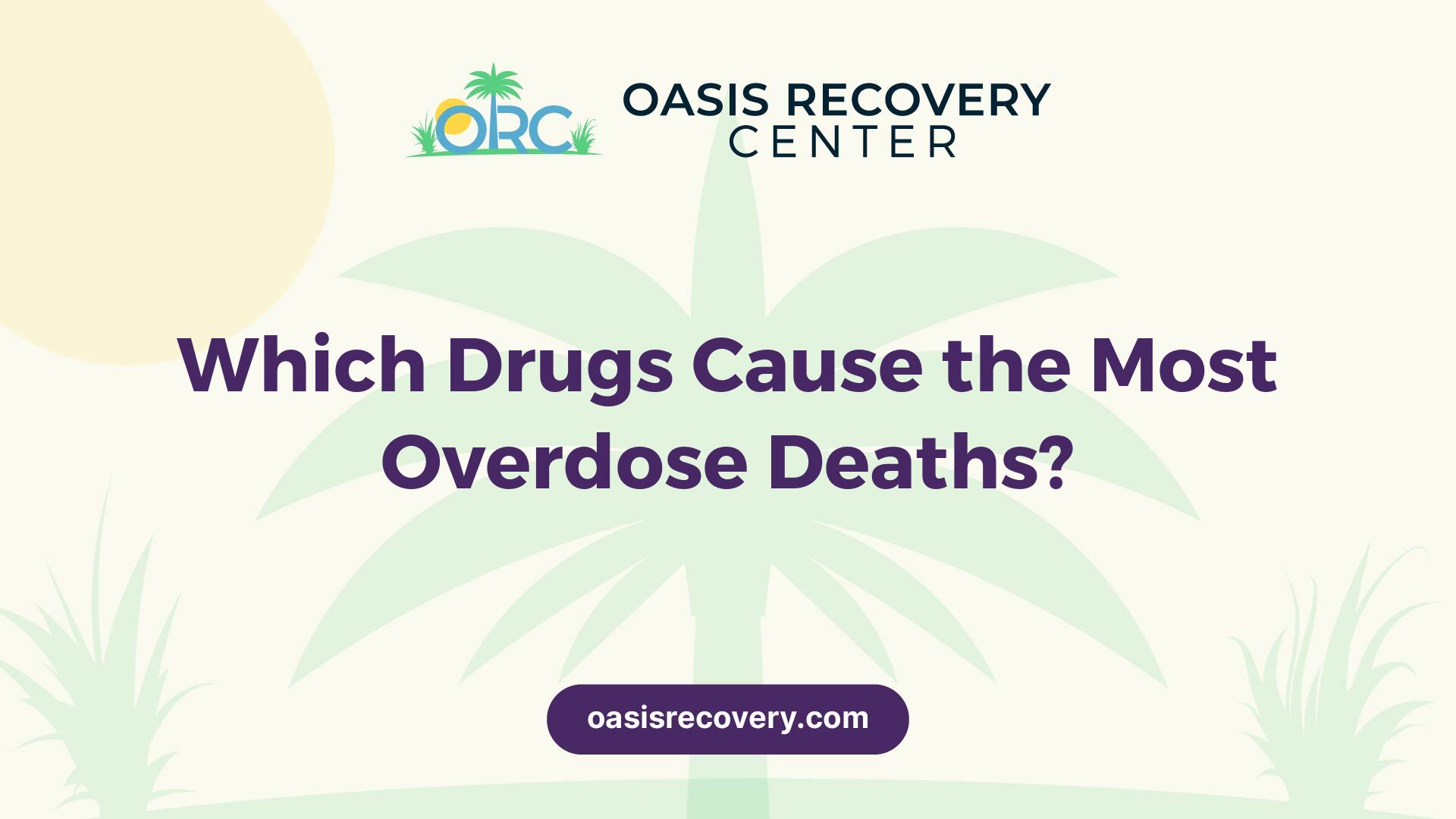
Which Drugs Cause the Most Overdose Deaths?

Understanding the Impact of Fatal Drugs
Introduction to Drug-Related Deaths
The landscape of drug use in America has changed dramatically over the years, leading to a significant increase in drug-related fatalities. Fatal drug overdoses pose a serious public health issue and affect families, communities, and the nation as a whole. Understanding the factors contributing to these deaths can help in grasping the seriousness of the situation.
Statistics on Overdose Deaths in America
According to recent data, overdose deaths have escalated to alarming rates, particularly concerning various categories of substances. The numbers indicate a drastic trend, highlighting the most lethal drugs that contribute to this crisis.
Year Total Overdose Deaths Total Opioid-Related Synthetic Opioid Methamphetamine Cocaine Benzodiazepine 2018 67,367 46,802 31,335 15,553 14,666 11,537 2019 70,630 50,179 36,499 16,167 15,443 11,049 2020 93,331 56,064 36,359 23,387 19,447 13,038 2021 107,622 75,673 47,299 33,483 22,617 13,038
The table reflects the growing impact of drugs on public health and emphasizes which substances have become particularly dangerous in recent years. Opioids continue to lead in overdose fatalities, with synthetic opioids like fentanyl driving many of these tragic outcomes.

Most Fatal Drugs in America
The issue of drug-related fatalities has reached alarming levels in America. Various substances have been linked to numerous overdose deaths, each contributing differently to the ongoing crisis.
Opioids
Opioids are a class of drugs that include both prescription medications and illegal substances such as heroin. These substances bind to opioid receptors in the brain, significantly decreasing pain perception but also carrying a high risk of addiction and overdose.
Year Overdose Deaths (Opioids) 2017 47,600 2018 49,860 2019 50,000 2020 69,710
Synthetic Opioids
Synthetic opioids, particularly fentanyl, are among the most dangerous drugs. These substances are often mixed with other drugs, which increases the risk of accidental overdoses. The potency of synthetic opioids exceeds that of traditional opioids, making them a significant factor in drug-related deaths.
Year Overdose Deaths (Synthetic Opioids) 2017 28,400 2018 32,000 2019 36,500 2020 57,700
Methamphetamine
Methamphetamine is a powerful stimulant that affects the central nervous system. Its use has surged in recent years, leading to a rise in overdose deaths. Users often experience prolonged euphoria but risk severe health issues, including addiction and fatal overdoses.
Year Overdose Deaths (Methamphetamine) 2017 12,000 2018 16,500 2019 22,000 2020 27,000
Cocaine
Cocaine, derived from coca leaves, is another substance linked to overdose deaths. It can cause intense short-term euphoria but carries risks of heart problems, seizures, and respiratory failure, particularly when mixed with other drugs.
Year Overdose Deaths (Cocaine) 2017 13,000 2018 15,000 2019 15,500 2020 19,000
Benzodiazepines
Benzodiazepines are prescription medications often used to treat anxiety and insomnia. They can be addictive, and when combined with opioids or alcohol, the risk of overdose significantly increases.
Year Overdose Deaths (Benzodiazepines) 2017 11,000 2018 12,000 2019 13,000 2020 16,500
Alcohol
Alcohol remains one of the leading contributors to substance-related deaths. Chronic use, binge drinking, and alcohol mixed with other drugs can lead to dangerous health consequences and increase the likelihood of overdose.
Year Overdose Deaths (Alcohol) 2017 26,000 2018 27,000 2019 28,200 2020 30,000
Understanding the most fatal drugs in America is crucial for addressing the crisis of overdose deaths. Each substance presents unique risks and demands targeted interventions to reduce their impact on public health.
Factors Contributing to Overdose Deaths
Understanding the factors that lead to overdose deaths is crucial for addressing the ongoing crisis. Several elements contribute to the rise in drug-related fatalities, including accessibility, drug purity, and co-occurring mental health disorders.
Accessibility and Availability of Drugs
The availability of drugs plays a significant role in overdose deaths. Easy access to both prescription medications and illicit drugs has increased the likelihood of misuse. This is particularly evident with opioids, which are frequently overprescribed and readily available on the black market.
Type of Drug Accessibility Level Prescription Opioids High Synthetic Opioids (e.g., Fentanyl) High Methamphetamine Moderate Cocaine Moderate Benzodiazepines High Alcohol Very High
Drug Purity and Potency
Higher purity and potency levels in drugs can lead to an increased risk of overdose. Many drugs, especially synthetic opioids, are significantly stronger than anticipated. This is particularly dangerous for users who are unaware of the specific strength of the substance they are consuming.
Drug Type Average Potency Level Overdose Risk Opioids Varies (can exceed 100mg of morphine equivalent) High Synthetic Opioids Very High (often 50-100 times stronger than morphine) Very High Methamphetamine High (purity often >80%) High Cocaine Moderate (purity varies widely) Moderate Benzodiazepines Moderate (stronger formulations available) Moderate
Co-occurring Mental Health Disorders
Mental health issues often coexist with substance use disorders. Individuals struggling with depression, anxiety, or other mental health problems may turn to drugs as a coping mechanism. This can exacerbate the risk of overdose, especially when combined with potent substances.
Mental Health Disorder Overdose Risk Depression High Anxiety Disorders Moderate Bipolar Disorder High PTSD Moderate Schizophrenia High
These factors create a complex landscape that contributes to the alarming rise in overdose deaths in America. Addressing these elements is essential in developing effective prevention and intervention strategies.
Effects and Risks of Fatal Drugs
Understanding the effects of fatal drugs is vital for grasping the severity of the overdose crisis in America. This section will explore both the short-term effects of these substances and the long-term health consequences they may cause.
Short-Term Effects
The immediate effects of drugs can vary considerably based on the type of substance consumed. Below is a table summarizing the common short-term effects associated with some of the most fatal drugs.
Drug Class Short-Term Effects Opioids Euphoria, drowsiness, confusion, respiratory depression Synthetic Opioids Extreme sedation, nausea, pin-point pupils Methamphetamine Increased energy, rapid heart rate, anxiety, paranoia Cocaine Intense euphoria, increased alertness, restlessness Benzodiazepines Sedation, dizziness, impaired coordination Alcohol Impaired judgment, slurred speech, loss of coordination
These short-term effects can lead to dangerous situations, including accidents, risky behavior, and overdose.
Long-Term Health Consequences
Prolonged use of fatal drugs often results in serious health complications. The table below outlines some of the potential long-term health consequences associated with various drug classes.
Drug Class Long-Term Health Consequences Opioids Dependency, chronic pain, liver damage Synthetic Opioids Addiction, cognitive decline, respiratory issues Methamphetamine Heart damage, severe dental problems, mental health disorders Cocaine Increased risk of heart attacks, stroke, respiratory issues Benzodiazepines Dependency, cognitive impairment, increased anxiety Alcohol Liver disease, cardiovascular issues, dependency
These health consequences underscore the critical need for effective prevention and intervention strategies regarding America’s killer drugs and the overdose crisis.
Prevention and Intervention Strategies
Addressing the challenges posed by fatal drugs requires a comprehensive approach that includes public health initiatives, harm reduction programs, and treatment and rehabilitation services. These strategies aim to mitigate the impact of drugs associated with high overdose death rates.
Public Health Initiatives
Public health initiatives focus on raising awareness about the dangers of drug use and the overdose crisis. These programs aim to educate the population on the risks associated with different substances and promote preventive measures.
Initiative Type Description Awareness Campaigns Informing the public about overdose risks and prevention measures through various media platforms. School Programs Implementing drug education curricula in schools to inform students about the dangers of drug use from an early age. Community Outreach Engaging with communities to provide resources, education, and support for those affected by substance use.
Harm Reduction Programs
Harm reduction programs prioritize minimizing the negative consequences of drug use rather than solely focusing on abstinence. These programs provide practical strategies to ensure user safety and promote health.
Program Type Description Needle Exchange Programs Offering clean needles to reduce the transmission of infectious diseases among intravenous drug users. Safe Consumption Spaces Providing areas where individuals can use drugs under supervision, preventing overdose fatalities. Naloxone Distribution Increasing access to naloxone, an opioid overdose reversal medication, to save lives in emergency situations.
Treatment and Rehabilitation Services
Effective treatment and rehabilitation services are critical in helping individuals struggling with substance use disorders. These services focus on recovery and support for those affected by drug addiction.
Service Type Description Inpatient Rehabilitation Offering intensive treatment programs in a controlled environment to help individuals detox and recover from addiction. Outpatient Treatment Providing therapy and support for individuals seeking recovery while allowing them to maintain daily responsibilities. Counseling and Support Groups Connecting individuals with peer support and counseling services to address emotional and psychological aspects of addiction.
Implementing these prevention and intervention strategies can play a significant role in reducing the impact of drugs that lead to high overdose death rates. By focusing on education, safety, and recovery, communities can better navigate the challenges posed by America’s killer drugs.
Moving Forward
Addressing the Ongoing Crisis
America's ongoing crisis with fatal drug overdoses requires immediate and effective responses. Addressing this issue involves a multifaceted approach targeting prevention, treatment, and policy reform. Collaboration among healthcare providers, policymakers, and communities is essential to implement comprehensive strategies.
Key areas of focus include:
Increasing Access to Treatment: Expanding treatment options for substance use disorders can help individuals find the support they need. This includes medication-assisted treatment and counseling services.
Enhancing Law Enforcement Strategies: Strengthening law enforcement efforts to combat the distribution of deadly drugs is critical. This includes cracking down on illegal drug trafficking and providing training for first responders.
Supporting Research and Development: Investing in research to develop new treatment options and better understand addiction can lead to more effective intervention strategies.
The following table presents data on drug overdose deaths in America, illustrating the urgency of addressing this crisis.
Year Total Overdose Deaths Total Opioid-related Psychostimulant-related 2018 67,367 47,600 14,800 2019 70,630 50,177 18,000 2020 93,331 68,632 23,000 2021 107,622 81,000 28,000
Encouraging Awareness and Education
Increasing awareness and education about the dangers of drugs contributing to overdose deaths is crucial. Public education campaigns can inform individuals about the risks associated with drug use and the need for prevention strategies.
Educational initiatives should focus on:
Identifying Signs of Addiction: Teaching individuals how to recognize the signs of addiction can help initiate early intervention.
Understanding the Dangers of Mixed Substances: Many overdoses occur due to the combination of multiple substances. Educating the public about the risks of mixing drugs can reduce incidents of overdose.
Promoting Safe Disposal of Medications: Encouraging safe disposal practices for unused or expired medications can help prevent misuse and curb easy access to potentially harmful substances.
The table below outlines potential educational initiatives aimed at combating drug overdoses.
Initiative Description Community Workshops Interactive sessions focusing on awareness and prevention of substance use disorders. School Programs Curriculum integration about the dangers of drugs and coping strategies for students. Social Media Campaigns Utilizing platforms to reach a broader audience with information on drug risks and available resources.
A united effort in addressing the ongoing crisis through education and community engagement will pave the way for reducing the impact of America’s killer drugs – those that cause the most overdose deaths.

